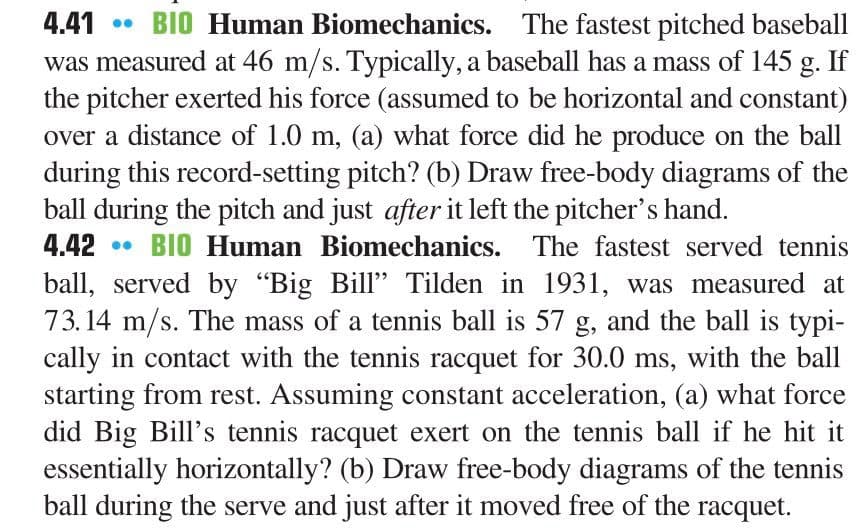4.41 • BIO Human Biomechanics. The fastest pitched baseball was measured at 46 m/s. Typically, a baseball has a mass of 145 the pitcher exerted his force (assumed to be horizontal and constant) over a distance of 1.0 m, (a) what force did he produce on the ball during this record-setting pitch? (b) Draw free-body diagrams of the ball during the pitch and just after it left the pitcher's hand. g. If
4.41 • BIO Human Biomechanics. The fastest pitched baseball was measured at 46 m/s. Typically, a baseball has a mass of 145 the pitcher exerted his force (assumed to be horizontal and constant) over a distance of 1.0 m, (a) what force did he produce on the ball during this record-setting pitch? (b) Draw free-body diagrams of the ball during the pitch and just after it left the pitcher's hand. g. If
Physics for Scientists and Engineers: Foundations and Connections
1st Edition
ISBN:9781133939146
Author:Katz, Debora M.
Publisher:Katz, Debora M.
Chapter5: Newton's Laws Of Motion
Section: Chapter Questions
Problem 47PQ: A block with mass m1 hangs from a rope that is extended over an ideal pulley and attached to a...
Related questions
Question
4.41 and 4.42

Transcribed Image Text:4.41
• BIO Human Biomechanics. The fastest pitched baseball
was measured at 46 m/s. Typically, a baseball has a mass of 145 g. If
the pitcher exerted his force (assumed to be horizontal and constant)
over a distance of 1.0 m, (a) what force did he produce on the ball
during this record-setting pitch? (b) Draw free-body diagrams of the
ball during the pitch and just after it left the pitcher's hand.
4.42 • BIO Human Biomechanics. The fastest served tennis
ball, served by "Big Bill" Tilden in 1931, was measured at
73.14 m/s. The mass of a tennis ball is 57 g, and the ball is typi-
cally in contact with the tennis racquet for 30.0 ms, with the ball
starting from rest. Assuming constant acceleration, (a) what force
did Big Bill's tennis racquet exert on the tennis ball if he hit it
essentially horizontally? (b) Draw free-body diagrams of the tennis
ball during the serve and just after it moved free of the racquet.
Expert Solution
This question has been solved!
Explore an expertly crafted, step-by-step solution for a thorough understanding of key concepts.
This is a popular solution!
Trending now
This is a popular solution!
Step by step
Solved in 3 steps with 1 images

Knowledge Booster
Learn more about
Need a deep-dive on the concept behind this application? Look no further. Learn more about this topic, physics and related others by exploring similar questions and additional content below.Recommended textbooks for you

Physics for Scientists and Engineers: Foundations…
Physics
ISBN:
9781133939146
Author:
Katz, Debora M.
Publisher:
Cengage Learning

Physics for Scientists and Engineers
Physics
ISBN:
9781337553278
Author:
Raymond A. Serway, John W. Jewett
Publisher:
Cengage Learning

Physics for Scientists and Engineers with Modern …
Physics
ISBN:
9781337553292
Author:
Raymond A. Serway, John W. Jewett
Publisher:
Cengage Learning

Physics for Scientists and Engineers: Foundations…
Physics
ISBN:
9781133939146
Author:
Katz, Debora M.
Publisher:
Cengage Learning

Physics for Scientists and Engineers
Physics
ISBN:
9781337553278
Author:
Raymond A. Serway, John W. Jewett
Publisher:
Cengage Learning

Physics for Scientists and Engineers with Modern …
Physics
ISBN:
9781337553292
Author:
Raymond A. Serway, John W. Jewett
Publisher:
Cengage Learning

College Physics
Physics
ISBN:
9781938168000
Author:
Paul Peter Urone, Roger Hinrichs
Publisher:
OpenStax College

University Physics Volume 1
Physics
ISBN:
9781938168277
Author:
William Moebs, Samuel J. Ling, Jeff Sanny
Publisher:
OpenStax - Rice University